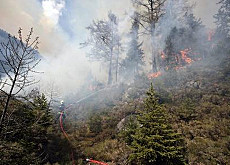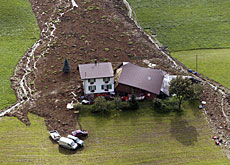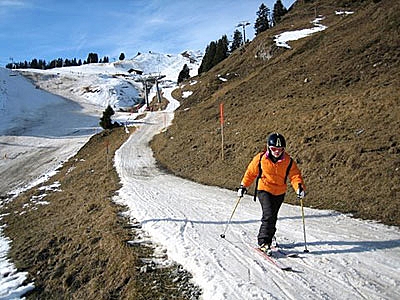Forest fire alert due to warm, dry weather

The Swiss Federal Environment Office has put the country on alert, warning of a high risk of forest fires due to the lack of rain and unseasonably warm weather.
A high-pressure area over part of western Europe has determined the weather in Switzerland over the past two weeks.
Several forest fires have been reported over the past few days in areas of both southern and northern Switzerland.
The environment office in Bern said forests across the country were dry, with a few exceptions in central Switzerland.
The southern canton of Ticino has announced a total ban on the lighting of fires while canton Jura in the west of the country and Graubünden in the southeast have prohibited fires in forests or near wooded areas.
The environment office and the authorities in many cantons that have not yet introduced bans have called on the Swiss to exercise caution.
The national weather service, MeteoSwiss, says there is no relief in sight. The forecast for this weekend is for more of the same: clear skies and temperatures in the mid 20s Celsius.
MeteoSwiss said summer-like temperatures are unusual for the first half of April; this year they climbed into the mid-20s for a few days.
Record highs for this time of year were registered in Sion in canton Valais (26.9°C), Glarus in eastern Switzerland (25.4°C), Geneva (25.3°C) and the mountain resort of Davos (18.8°C).
Exceptionally warm Aprils were also recorded in 1865, 1949 and 1952.
Follows warm winter
The unusually warm start to spring follows the warmest winter and autumn on record since measurements began 140 years ago.
Temperatures between September and November were nearly twice as high as the 1961-1990 average.
The warm winter weather was reflected in a lack of snow. Many ski resorts with runs concentrated below 1,500m were unable to operate for much of the season.
A snowstorm in the third week of March that brought up to 90cm to some areas was the only exception.
The dearth of snow this winter should lead to the opening of mountain pass roads earlier than usual. The cantonal authorities in Uri said they expected to have the Gotthard pass cleared by the first week of May – three weeks ahead of schedule.
Most traffic uses the Gotthard road tunnel, which is the main north-south artery through the Swiss Alps.
swissinfo with agencies
Warmest location: Locarno-Monti 11.5°C (annual average)
Highest temperature: Grono (GR) 41.5°C August 11, 2003
Coldest location: Jungfraujoch -7.9°C (annual average)
Coldest temperature: La Brévine -41.8°C January 12, 1987
Highest rainfall in 1 day: Camedo TI, 414mm September 10, 1983
Highest rainfall in 1 year: Mönchsgrat 5,910mm, 1939/40
Driest location: Ackersand VS 521mm (annual average)
Longest dry period: Lugano 77 days (from December 6, 1988)
Highest new snowfall (per day): Klosters 130cm January 29/30, 1982
Highest snow amount: Säntis 816cm April 1999

In compliance with the JTI standards
More: SWI swissinfo.ch certified by the Journalism Trust Initiative



You can find an overview of ongoing debates with our journalists here. Please join us!
If you want to start a conversation about a topic raised in this article or want to report factual errors, email us at english@swissinfo.ch.